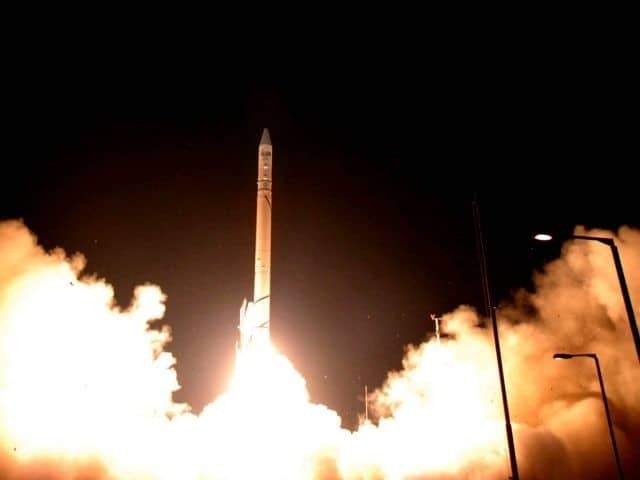Israel Announces Successful Launch of New Spy Satellite

Israel’s Defense Ministry announced the successful launch of a new spy satellite early on Monday that would help the country monitor Iran’s nuclear activity as its foreign minister hinted that Israel may have been behind a fire that damaged an Iranian nuclear site last week.
The “Ofek 16” satellite gives Israel what officials described as an additional tool in keeping tabs on many threats from across the region, joining a fleet of Israeli spy satellites that have been launched over the past two decades. While officials did not identify specific threats, arch-enemy Iran, which Israel accuses of trying to develop nuclear weapons, is first among them.
The launch came a day after Iran finally acknowledged that a mysterious fire last week damaged a new centrifuge assembly center in Iran’s underground Natanz nuclear site, with suspicion immediately falling on Israel.
Iranian officials had initially sought to downplay Thursday’s fire, calling it an “incident” that affected an “industrial shed.” But on Sunday they confirmed that centrifuges had been damaged and their development and production delayed. It comes amid a spate of other mysterious explosions at Iranian industrial complexes in recent months that have also been attributed to Israel.
Israel has previously proven its ability to penetrate sensitive Iranian facilities, including with the 2018 raid in Tehran when Israeli officials said Mossad agents broke into a warehouse and stole thousands of documents connected to Iran’s nuclear program. Israel and the U.S. are also believed to have been behind the Stuxnet computer virus that disrupted Iran’s nuclear program a decade ago.
Israel has not officially commented on the fire in Natanz, in line with its standard policy of neither confirming nor denying secretive overseas operations.
But in a speech, Foreign Minister Gabi Ashkenazi noted that it was Israel’s long-term strategy to prevent Iran from having the ability to build a nuclear weapon.
Without mentioning Natanz, Ashkenazi, who was Israel’s military chief during the Stuxnet period, said at a conference that Israel takes “actions that are better left unsaid.”
The leader of his Blue and White party, Defense Minister Benny Gantz, warned in a radio interview Sunday that while it was understandable to suspect Israel, “not every incident that happens in Iran necessarily has something to do with us.”
Gantz, like Ashkenazi a former military chief of staff, called Monday’s satellite launch an “extraordinary achievement.”
“Technological superiority and intelligence capabilities are essential to the security of the state of Israel,” he said.
Israel, as a rule, does not confirm the number of its operational satellites but Amnon Harari, the head of the ministry’s Space and Satellite Administration, mentioned at least two others, the Ofek 5, launched in 2002, and the Ofek 11, launched in 2016. He said that having additional spy satellites improved the speed and depth at which Israel can gather intelligence.
“All the group of satellites are being used to monitor any threats on the state of Israel, which as you know are sometimes far away and immediate so they require constant monitoring,” he said. “You can assume that once you have more than one satellite in parallel in the sky, you achieve better visit times over the targets of interest.”
The satellite was developed by the ministry, along with the state-owned Israel Aerospace Industries. The ministry said Ofek 16 was launched at 4 a.m. from the Palmachim air base in central Israel into space. It described the Ofek as an “electro-optical reconnaissance satellite with advanced capabilities.”
Shlomi Sudri, the general manager of IAI’s space division, said the Ofek was in orbit and sending “healthy signals” to a ground station. He said he expected it to begin transmitting photos in about a week.
Israel considers Iran to be its greatest threat, citing its development of long-range missiles, its military presence in neighboring Syria and its suspect nuclear program, and it keeps a close eye on Iran.
Alex Fishman, the defense analyst of the Yedioth Ahronot daily, said the suspicion that Israel was involved in last week’s fire at the Natanz nuclear site made sense.
“Someone decided that a window of opportunity had opened, that Iran was in distress, and that now was the time to strike wherever possible,” he wrote. “Now, when Iran is suffering from a huge socio-economic crisis, that is the time to try to destabilize the regime, to encourage domestic resistance, to compel Iran to invest money in defense and in rebuilding infrastructure at the expense of its military projects.”
Iran has yet to outright accuse Israel. A spokesman for its nuclear agency, Behrouz Kamalvandi, said Sunday that work had begun on the Natanz center in 2013 and it was inaugurated in 2018.
He said that the fire had damaged “precision and measuring instruments,” and that the center had not been operating at full capacity due to restrictions imposed by Tehran’s 2015 nuclear deal with world powers. Iran began experimenting with advanced centrifuge models in the wake of the U.S. unilaterally withdrawing from the deal two years ago.
Photo: Israeli Aerospace Industries via Getty











